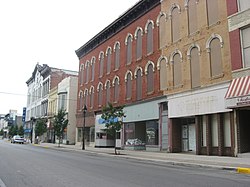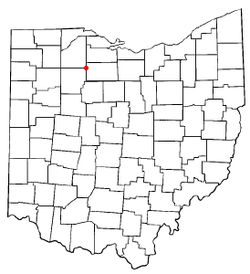Fostoria, OH
| Fostoria, Ohio | |
|---|---|
| City | |

Main Street in downtown Fostoria
|
|
 Location of Fostoria, Ohio |
|
 Location of Fostoria in Seneca County |
|
| Coordinates: 41°9′33″N 83°24′55″W / 41.15917°N 83.41528°WCoordinates: 41°9′33″N 83°24′55″W / 41.15917°N 83.41528°W | |
| Country | United States |
| State | Ohio |
| Counties | Seneca, Hancock, Wood |
| Government | |
| • Mayor | Eric Keckler |
| Area | |
| • Total | 7.77 sq mi (20.12 km2) |
| • Land | 7.55 sq mi (19.55 km2) |
| • Water | 0.22 sq mi (0.57 km2) |
| Elevation | 781 ft (238 m) |
| Population (2010) | |
| • Total | 13,441 |
| • Estimate (2012) | 13,282 |
| • Density | 1,780.3/sq mi (687.4/km2) |
| Time zone | Eastern (EST) (UTC-5) |
| • Summer (DST) | EDT (UTC-4) |
| ZIP code | 44830 |
| Area code(s) | 419, 567 |
| FIPS code | 39-28014 |
| GNIS feature ID | 1064668 |
| Website | www |
Fostoria is a city located at the convergence of Hancock, Seneca, and Wood counties in the northwestern part of the U.S. state of Ohio. It is approximately 40 miles (64 km) south of Toledo and 90 miles (140 km) north of Columbus.
The city is known for its railroads, as 100 trains pass through the city each day. The city is often visited by railfans, and a railroad viewing park is under construction (2013). Fostoria was also the home for over a dozen glass factories during the end of the 19th century. The glass factories were established in Fostoria because of the discovery of natural gas in the area. As the gas supply became depleted, many of the factories closed or moved—including the Fostoria Glass Company. Fostoria's most famous citizen is Charles Foster (son of the man who helped establish Fostoria), who became governor of Ohio.
The community grew substantially during the end of the 19th century, coinciding with the northwest Ohio gas boom. Typical of Rust Belt cities, Fostoria peaked in size in 1970. The population was 13,441 at the 2010 census.
Fostoria was created in 1854 with the merger of the communities of Rome and Risdon. The combination of the two communities' Methodist churches, on land donated by Charles W. Foster, led to the merger. To show their appreciation for Mr. Foster's generosity, the new community was named Fostoria. Charles W. Foster's son, Charles, became one of Fostoria's most famous citizens—becoming the 35th governor of Ohio and U.S. Secretary of the Treasury under President Benjamin Harrison.
Fostoria is known for its glass heritage and railroads: two CSX main lines and one NS main line intersect in downtown Fostoria, an area called the "Iron Triangle." A natural gas boom in the 1880s, the railroad lines, and recruiting efforts by the community caused Fostoria to become home for numerous glass factories, including the Mambourg Glass Company (the city's first glass factory), the Fostoria Glass Company, the Seneca Glass Company, the Novelty Glass Company, and others.
...
Wikipedia
